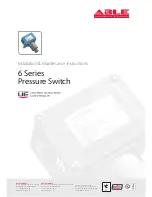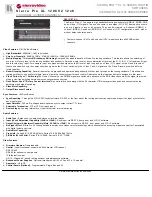
9
4.8
Field Taping of Electrical Connections
4.8.1
Materials
a. Filler – insulation putty – GE Part #: 55A213957
b. Insulating tape – black, linerless H.V. EPR tape – GE Part # MMC#130C1 (1”) or MMC#130C2 (2”)
4.8.2
Procedure
a. Clean area of dirt and foreign matter per Section 6.0.2
b. Apply filler – installation putty – over bare conductor and hardware to cover and smooth out the surface.
Blend contour into preinsulation surfaces. Cover conductors and hardware with at least
1
⁄
8
” of filler.
c. Apply insulating tape, lapping and layering as specified in chart below. Tape must overlap factory installed
insulation by 1". Elongate insulating tape 10 to 25 percent during application to insure a smooth, tight fit.
Should a tape roll be used up, start the new roll by overlapping any previous end by
1
⁄
2
turn.
4.9
Securing Switchgear to Foundations
All anchoring hardware and necessary devices are to be supplied by the installer.
Indoor and outdoor units can be secured to the foundation using
1
⁄
2
" diameter anchor bolts (SAE Grade 5 or
stronger). The four
5
⁄
8
" holes in the base for these bolts are shown on the floor plan included with the drawings.
4.10
Connection of Space Heaters to Customer Source
Space heaters, when supplied, must be energized to prevent condensation. Heaters are supplied for 120 or 240
volt sources as shown on drawings.
For lineups or units with heater control devices, heaters will be internally wired and brought to a terminal block. A
wiring diagram will be furnished with the drawings showing connection points for power.
4.11
Switch Inspection Before Setup
The following procedure should be performed to insure proper operation of the switch. Open and close the switch
2-5 times in succession. Do not attempt to grind the blades with powdered emery or other abrasives. Such prac-
tice inevitably results in poor contact and overheating.
Switch contact adjustment should be checked as follows:
1. Operate the switch several times checking for main blade and arcing blade alignment with the stationary con-
tacts and arc chute.
2. Check switch resistance by using a low resistance ohm meter connected between the jaw spade terminal and
the hinge spade terminals. Do this measurement of each pole of the assembly.
Any low resistance meter capable of measurements in the micro-ohm range may be used.
Suitable meters include:
Valhalla Scientific, Inc.
Biddle Instruments
Model 4150 ATC
Cat. No. 247350
Digital Ohmmeter
Digital Low Resistance Ohmmeter
If the switch does not move freely or the resistance is over 80 micro-ohms then the switch must be readjusted
using the following switch alignment procedure and adjustment procedure (see Section 4.11.1).
Chart 1: Taping Chart
Lap of Tape
No. of Layers
Up to 5 kV
1
⁄
2
1
Over 5 kV to 15 kV
2
⁄
3
2
CAUTION
The hinge and jaw contacts are sliding joints and overtightening can cause
the switch not to open and severely damage the mechanism.
!
BreakMaster Load Interrupter Switch











































